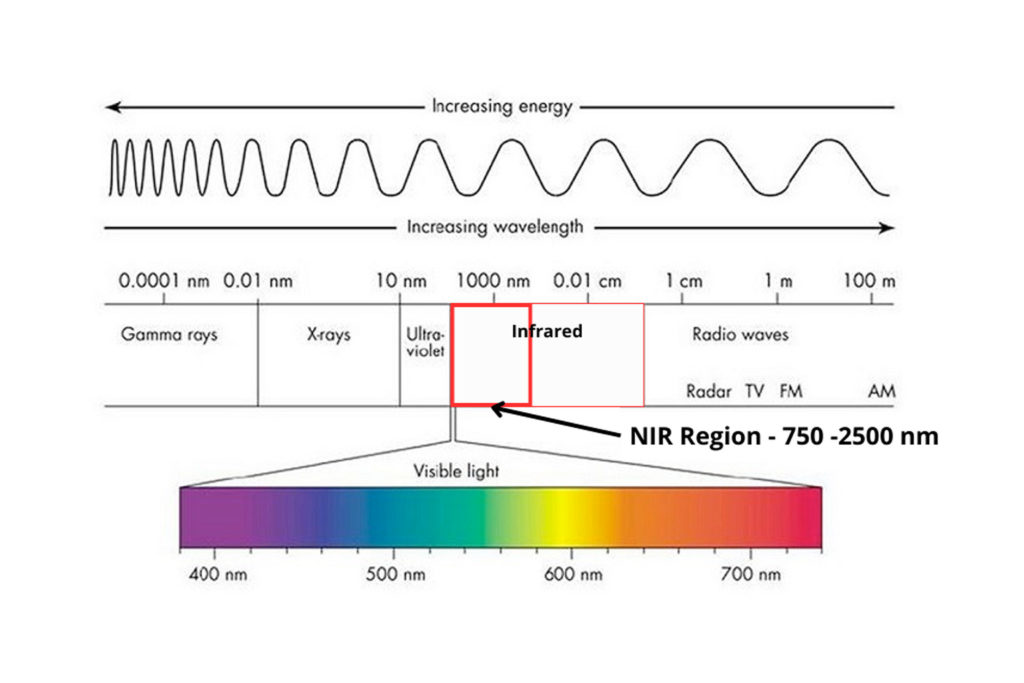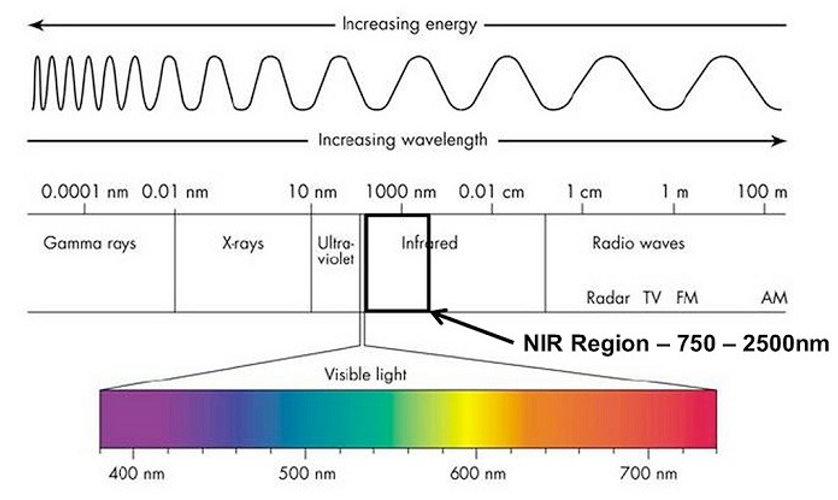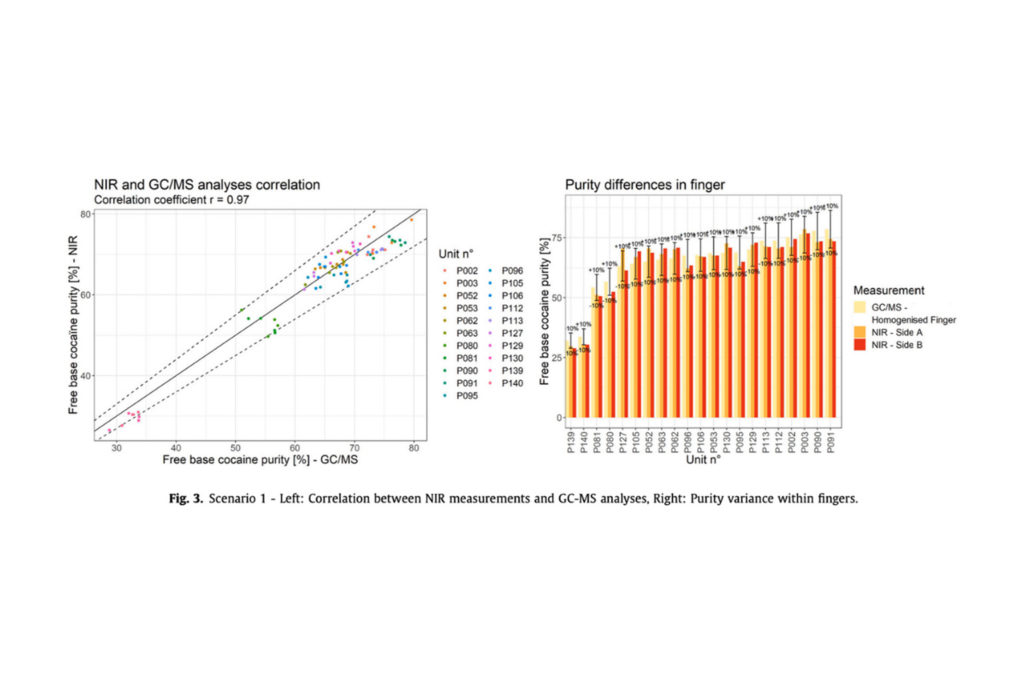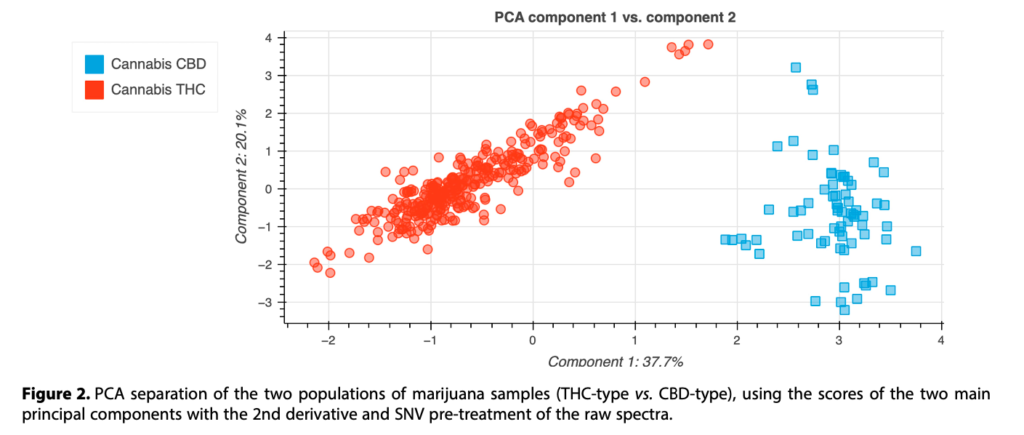
Near-Infrared Spectroscopy (NIR) stands as a beacon in the realm of material identification, bridging the gap between the unseen molecular world and practical applications that touch our everyday lives. This technique, although rooted in complex scientific principles, has a straightforward goal: to identify and analyze materials quickly and accurately.
At its core, NIR spectroscopy is a method that uses the near-infrared region of the electromagnetic spectrum. It’s akin to shining a unique type of light onto a substance and observing how this light is absorbed and reflected. The patterns of absorption and reflection are like molecular fingerprints, revealing detailed information about the material’s composition.
In this blog, we will explore the fascinating world of Near-Infrared spectroscopy, breaking down its technical aspects into digestible concepts. From its basic principles and historical evolution to its pivotal role in material identification across various industries, we aim to unveil the science behind NIR in a manner that is engaging and accessible to all.
Basic Principles of NIR
Near-Infrared spectroscopy operates in the electromagnetic spectrum ranging from approximately 750 to 2500 nanometers (nm). In simpler terms, this means it uses a part of the light spectrum that is just beyond the range of what our eyes can see. The key to its functionality lies in analyzing overtones and combinations of vibrations from molecular bonds, particularly those involving hydrogen – like O-H, N-H, and C-H bonds.

The beauty of NIR lies in its simplicity and versatility. Unlike other analytical techniques, it requires minimal sample preparation. Often, samples can be analyzed just as they are, making it a swift and non-invasive method. However, the ease of sample preparation comes with a trade-off in complexity of interpretation. The spectral patterns in NIR are less straightforward than those in other regions, like mid-IR. This complexity requires advanced tools, known as chemometric methods, for accurate analysis.
For example, in biotechnology, Near-Infrared plays a crucial role in monitoring fermentation processes, tracking the concentrations of various biological molecules. Its spectra can reveal changes in complex media, aiding in the monitoring of nutrients, metabolites, and even biomass.
NIR spectroscopy is not without its challenges, though. The need for robust calibration, ongoing maintenance, and the complexities in transferring methods between instruments are some hurdles. Despite these, its advantages like non-destructiveness, speed, and cost-effectiveness in the long run make it an invaluable tool in material analysis.

Historical Development and Evolution of NIR
The journey of NIR spectroscopy began around 1800 with the discovery of the NIR region by William Herschel. However, it wasn’t until the mid-to-late 1960s that NIR started to be used as a practical analytical tool. Since then, especially from the 1990s, its application has soared across various industries, from food and agriculture to pharmaceuticals and polymers.
Initially, NIR spectroscopy’s development was driven by its application in hydrogen bonding and anharmonicity studies in the 1950s. A significant leap occurred in the 1980s and 1990s, with advancements in spectrometers, detectors, and computational methods, widening its application scope.
Pioneers like Karl Norris and Frans F. Jobsis played instrumental roles in NIR’s evolution. Norris’s statistical methods for building calibration models and Jobsis’s work in in vivo monitoring are particularly noteworthy. Their contributions paved the way for NIR’s widespread adoption in diverse fields.
Today, Near-Infrared spectroscopy has evolved into a versatile tool with applications in laboratories, factories, and even outdoor settings. Its ability to analyze solids, liquids, and gases highlights its adaptability and significance in material analysis.
NIR in Material Identification
The true prowess of NIR spectroscopy is showcased in its application for material identification and quantification. It’s like having a molecular-level detective at hand, capable of discerning the identity of various materials. This capability is especially valuable in industries where the composition and quality of materials are crucial.
Near-Infrared spectroscopy can identify and quantify a wide array of materials, ranging from pharmaceutical ingredients to agricultural products, and from polymers to textiles. It distinguishes between these materials by analyzing their molecular vibrations. Each material, due to its unique molecular structure, interacts with NIR light in a distinct way, creating a specific spectral pattern.
In the pharmaceutical industry, professionals use NIR to guarantee the quality of raw materials and finished products. It can detect impurities and verify the composition without destroying the sample. In agriculture, it helps in assessing the quality of crops and soil, determining factors like moisture content and nutrient levels.
What sets NIR apart is its non-destructive nature, allowing materials to be tested without alteration or damage. This feature is invaluable in industries where preserving the integrity of the sample is crucial.
Case Studies/Examples
To illustrate the power of NIR in material identification, let’s explore its significant applications in law enforcement, the cannabis industry, and polymer analysis.
In law enforcement, Near-Infrared (NIR) spectroscopy has become an indispensable tool for narcotics detection. It enables officers to swiftly and accurately identify and quantify various substances. This plays a vital role in drug enforcement and public safety. NIR technology can quickly determine whether a substance is an illicit drug and identify specific narcotics. This rapid and reliable tool is essential for law enforcement agencies, enhancing their capability to combat drug-related offenses effectively.
In the cannabis industry, NIR spectroscopy is crucial for quality control and regulatory compliance. It allows for the precise identification and quantification of cannabinoids, including THC and CBD levels. This technology ensures the safety and consistency of cannabis products, meeting the legal requirements and standards set for consumer protection. NIR’s non-destructive analysis is particularly valuable in maintaining product integrity while adhering to regulatory standards.
Additionally, in the polymer industry, NIR spectroscopy is a key technology for quality control and product development. It offers a quick and accurate method for identifying and quantifying polymer types, monitoring molecular weight, and ensuring the desired chemical composition. This application is especially important in industries where the precise composition of materials is critical, such as in manufacturing high-performance plastics and other polymer-based products.
These examples demonstrate the versatility and impact of NIR spectroscopy in various fields, highlighting its importance in material identification across different industries.
Advantages and Limitations
NIR spectroscopy offers several advantages in material identification. Its non-destructiveness means samples can be analyzed without being altered or destroyed. This feature is crucial in industries where sample integrity is paramount. Additionally, NIR analysis is fast and efficient, providing results in a matter of seconds to minutes.
Another significant advantage is its versatility. NIR can analyze a wide range of materials, from organic compounds in pharmaceuticals to inorganic substances in minerals. This versatility makes it a valuable tool in diverse industries.
However, NIR also has its limitations. The interpretation of NIR spectra can be complex, often requiring specialized software and expertise. The initial setup costs and method development can be high, though these are offset by the rapid analysis and minimal ongoing expenses.
Despite these limitations, the advantages of NIR, especially in terms of speed, non-destructiveness, and versatility, make it an indispensable tool in material identification.
Future Trends and Developments
The future of NIR spectroscopy in material identification is bright and full of potential. Ongoing research is likely to lead to technological advancements that will further enhance its capabilities. One area of development is the miniaturization of NIR spectrometers, making them more portable and accessible. This advancement could extend NIR’s application to on-field testing, bringing laboratory-grade analysis to remote locations.
Another exciting development is the integration of NIR with artificial intelligence and machine learning. This integration could lead to smarter, more accurate, and more automated NIR analysis, reducing the need for expert intervention and making the technology more user-friendly.
As research continues, we can expect NIR spectroscopy to find new applications in emerging fields, further solidifying its role as a vital tool in material identification and quantification.
Conclusion
Throughout this blog, we have journeyed through the world of Near-Infrared (NIR) spectroscopy, uncovering its principles, history, applications, and future prospects. NIR stands not just as a scientific technique but as a testament to human ingenuity and our quest to understand and utilize the world around us.
The importance of NIR in material identification cannot be overstated. It is a tool that offers accuracy, efficiency, and versatility, making it indispensable in various industries. As we look to the future, the potential for further advancements in NIR technology promises to expand its application and impact even further.
Whether you’re a scientist, industry professional, or simply someone curious about the marvels of technology, NIR spectroscopy is a field worth exploring. Its ability to reveal the hidden secrets of materials has, and will continue to, significantly impact our world.
To explore more about spectroscopy and discover the full capabilities of NIRLAB’s technology, we invite you to read our other informative articles, here. For personalized inquiries, please don’t hesitate to reach out to us at contact@nirlab.com.
NIRLAB // Just Truth


